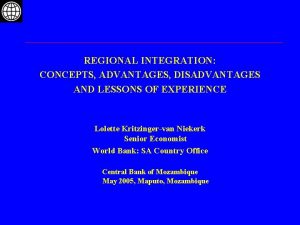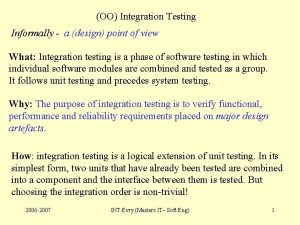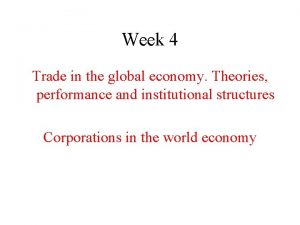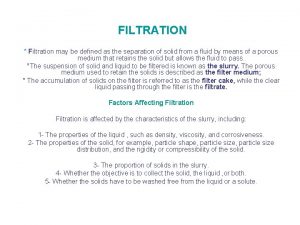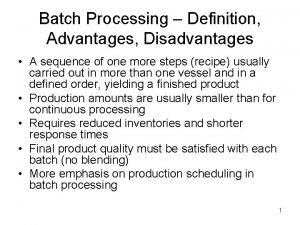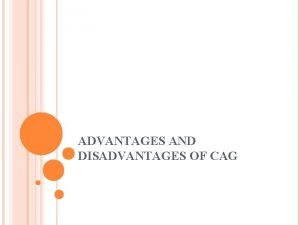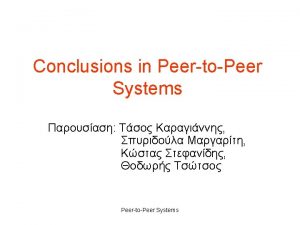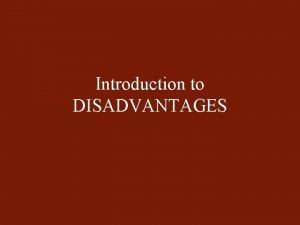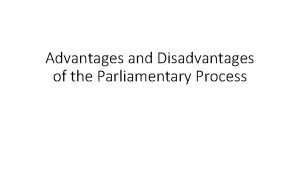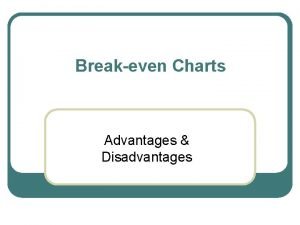REGIONAL INTEGRATION CONCEPTS ADVANTAGES DISADVANTAGES AND LESSONS OF















- Slides: 15

REGIONAL INTEGRATION: CONCEPTS, ADVANTAGES, DISADVANTAGES AND LESSONS OF EXPERIENCE Lolette Kritzinger-van Niekerk Senior Economist World Bank: SA Country Office Central Bank of Mozambique May 2005, Maputo, Mozambique

OUTLINE • Why Regional Integration? • What is Regional Integration • Pre-conditions and Principles for Regional Integration • Some Observations on Regional Integration in ESA

Why integration in Sub-Saharan Africa? Africa is the most fragmented continent • 47 small economies in SSA = Belgian economy or 50% of Spai Integration helps overcome fragmentation • • • Create larger markets to permit economies of scale, wider competition and increased foreign investment Accelerate opening of economies to the rest of the world Enhance credibility of national reform through lock-in policy mechanisms Strengthen unity for international negotiations Reduce/resolve inter-state conflicts

Why integration in Sub-Saharan Africa? • Traditional gains from RIAs – trade gains – Increased returns and competition – Increased Investment • Non-traditional gains from RIAs – – – Lock in to domestic reforms Signaling Insurance Coordination and bargaining power Security

Regional Integration & Trade an effective means for accelerating trade reform in Africa? • Empirical evidence suggests – UTL is superior to trade blocs – N-S RIAs are likely to be superior to S-S RIAs • Thus guiding principle: – Gains from S-S RTAs may be > • with deeper RTAs (it extent of trade diversion) & • with openness with rest of the world (generates usual ‘gains from trade’

Regional Integration and Trade an effective means for accelerating trade reform in Africa? Most African countries are members of regional trade blocs (FTAs or CUs) with a set of intra-regional and external trade policies (new trend for open regionalism based on open and free market) Serious implementation of RIAs rules by individual countries would lower, not higher trade barriers (“zero” intraregional tariff, and lower average external tariff) Example: UEMOA – average nominal tariff went down from ~ 25% (pre-1996) to 12% (2000). Intra-regional trade went up from ~10% (pre-1996) to to 14% (2000). Tariffs remain high for countries that did not implement reforms seriously (CEMAC, Nigeria).

Regional Integration and larger markets an effective means for positive scale and competition effects? • Empirical evidence suggests – Diversification towards manufacturing requires: scale, low transaction costs, “investment friendly” and “noticeable” economic space. Implied growth in manufacturing will go a long way to spur trade – regional as well as global – attract FDI and promote regional investment – However, positive scale & competition effects through UTL > through RIAs, but then often easier to do regionally from a political viewpoint – less competition, plus reciprocal • Guiding principle are: – Deeper regional integration: can help by enlarging and opening up the economic space, driving down production and transaction costs. – Broader substantive coverage than strictly ‘market integration’ may be required to address supply-side constraints

Pluses and Minuses of Regional Integration ‘Poland’ ‘EU’ ‘Brazil’ ‘Argentina’ ‘Burkin a Faso’ ‘Cote d’Ivoire’ ‘Kenya’ ‘EU’ POLITICAL: Security + 0 + + ? ? +? 0 Bargaining 0 0 + + 0 0 Being noticed 0 0 + + 0 0 Policy lock-in + 0 + + 0? +? 0 Cooperation + + + +? 0 Scale and competition + + +? 0? +? 0 Trade diversion -? 0 - -? -? 0 Fiscal - 0 -? - +? - 0 Trade and location + + +? - + +? 0 Technology transfer + 0 +? 0 0 + 0 ECONOMIC:

What is regional integration ? Integration understood to have three dimensions

GEOGRAPHIC SCOPE: RIAs in AFRICA AMU Algeria Libya Morocco Tunisia ECCAS São Tomé & Príncipe Ghana Nigeria Benin Togo Côte d’Ivoire Guinea-Bissau WAEMU Liberia Sierra Leone Nile Basin Initiative COMESA IGAD Mauritania ECOWAS Conseil de l’Entente CEMAC Somalia Cameroon Central African Rep. Gabon Chad Equat. Guinea Rep. Congo Cape Verde Gambia Djibouti Egypt Burundi* Rwanda* Niger Burkina Faso Ethiopia Eritrea Sudan DR Congo Mali Senegal Kenya* Uganda* Angola EAC Guinea ACRONYMS Mano River AMU: Arab Maghreb Union CBI: Cross Border Initiative CEMAC: Economic and Monetary Community of Central Africa CILSS: Permanent Interstate Committee on Drought Control in the Sahel COMESA: Common Market for Eastern and Southern Africa EAC: East African Community ECCAS: Economic Community of Central African States ECOWAS: Economic Community of Western African States IGAD: Inter-Governmental Authority for Development IOC: Indian Ocean Commission SACU: Southern African Customs Union 1/ Tanzania is also a member of the SADC: Southern African Development Community Nile Basin Initiative WAEMU: West African Economic and Monetary Union CILSS SADC Tanzania 1* Malawi* Zambia* Zimbabwe* SACU South Africa Botswana Lesotho Mauritius* Seychelles* Namibia* Swaziland* Comoros* Madagascar* Reunion Mozambique * CBI IOC

Substantive Coverage • Problems whose solutions lie in a regional approach and less at problems that are common to all the concerned countries. Three main categories of regional issues: • Regional commons which have no real national borders, such as certain infectious diseases (e. g. malaria) or air pollution. • Public goods with trans-boundary implications e. g. cooperation in the management of shared natural resources (e. g. watersheds and international rivers), or regional safety and security, requiring participation of all countries to increase likelihood of success of any approach. Imbalance between individual country costs and benefits may hamper progress on cooperation • Sectors which are best tackled through a regional integration approach also due to fragmentation e. g. convergence of macroeconomic policies harmonizing legal and regulatory frameworks; and improving scale and competition through the integration of infrastructure and markets for goods, finance, labor, and energy. Cooperation of all the countries greatly enhances the effectiveness of the sector. But still differences in range depth of sector/issue coverage among RIAs

Depth of Integration • Cooperation • Harmonisation • Integration

Pre-conditions for successful Regional Integration Political · Domestic peace/security in countries · Political and civic commitment and mutual trust among countries Economic · Stabilize: Minimum threshold of macro-economic and financial management in countries (price stability, realistic real exchange rates, etc. ) · Sufficiently broad national reforms to open markets

Key Principles for Successful Regional Integration • Openness: National and regional markets too small: openness to the rest of the world essential · Subsidiarity: Regional organizations should do only what national governments cannot do as well · Private sector leadership: Integration must be for the people; private sector is the engine of integration · Pragmatism: Variable geometry (countries join when ready and appropriate); variable speed (not all issues simultaneously); variable depth (degree of supranationality)

Concluding Observations Regional Integration in ESA • Major Common Challenges – Political stability, water vulnerability and HIV/AIDS pandemic • Overlapping Membership Issues • Institutional Issues • Policy Design Issues • Risk of Polarization
 Disadvantages of regional integration
Disadvantages of regional integration Big bang approach in testing
Big bang approach in testing Regionalization and globalization venn diagram
Regionalization and globalization venn diagram Three dimensions of corporate strategy
Three dimensions of corporate strategy Backwards intergration
Backwards intergration Example of simultaneous integration
Example of simultaneous integration Data level eai
Data level eai Integration basic concepts
Integration basic concepts Hub-and-spoke system pros and cons
Hub-and-spoke system pros and cons Soldering brazing welding
Soldering brazing welding Anaconda plan
Anaconda plan Plotter is input or output device
Plotter is input or output device Centrifugal filtration definition
Centrifugal filtration definition Tangential sawing disadvantages
Tangential sawing disadvantages Advantages and disadvantages of checklists and rubrics
Advantages and disadvantages of checklists and rubrics Batch processing advantages
Batch processing advantages
